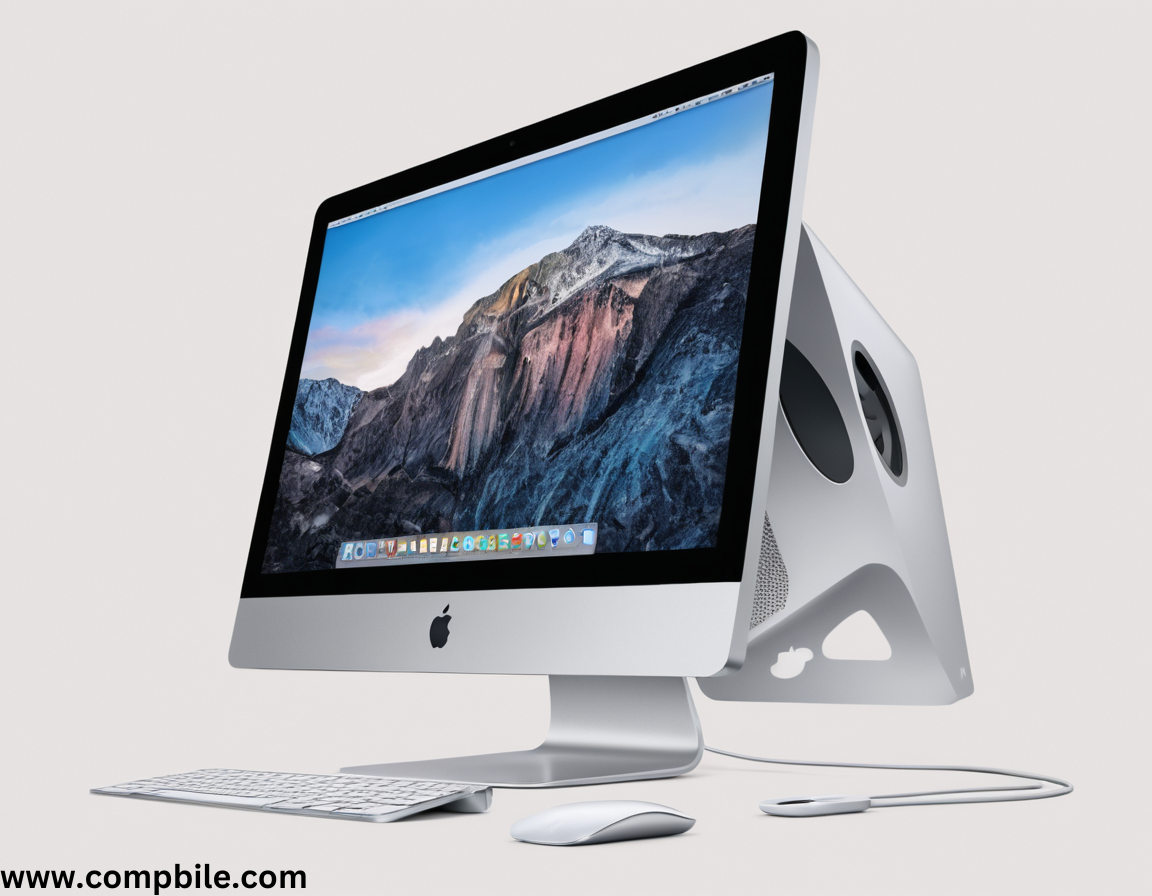apple imac m1 Slim Profile: The iMac M1 is thinner than previous models, thanks to the efficiency of the M1 chip, which allows for a smaller form factor without compromising performance.
- Color Options: It was the first iMac to be available in a variety of vibrant colors, reminiscent of the 1999 iMac G3, including blue, green, pink, silver, yellow, orange, and purple.
- 24-inch Retina Display: The iMac M1 comes with a 24-inch 4.5K Retina display with true-to-life colors, P3 wide color gamut, and 500 nits of brightness.
Performance
- M1 Chip: The M1 chip integrates CPU, GPU, RAM, and other components on a single chip, improving efficiency and speed. It has an 8-core CPU (4 high-performance and 4 high-efficiency cores) and up to an 8-core GPU (depending on the model), making it more powerful than many Intel-based iMacs.
- Unified Memory: The M1 iMac uses unified memory architecture (UMA), meaning that the CPU, GPU, and other components share the same memory pool. It comes with 8GB of RAM, which is configurable up to 16GB.
- Storage: SSD storage options range from 256GB to 2TB, providing fast read/write speeds.
Ports and Connectivity
- Thunderbolt/USB 4 Ports: The iMac M1 includes two or four Thunderbolt/USB 4 ports (depending on the model) for high-speed data transfer, external displays, and peripheral connections.
- USB-A Ports: It also has two USB-A ports for compatibility with older accessories.
- Ethernet Port: The M1 iMac has a built-in Gigabit Ethernet port (with an option for a 10Gb Ethernet port on higher models).
- Wi-Fi 6 & Bluetooth 5.0: For faster wireless connectivity.
Camera and Audio
- 1080p FaceTime HD Camera: The iMac features an upgraded 1080p camera, which delivers improved image quality over previous models.
- Studio-quality Microphones: The iMac M1 also includes a three-microphone array for better sound quality in video calls and recordings.
- Speakers: The iMac includes high-fidelity speakers with spatial audio and stereo sound, providing an improved audio experience.
Operating System
- macOS Big Sur (initially), macOS Monterey, and later versions: The iMac M1 ships with macOS Big Sur and is compatible with later versions like macOS Monterey, macOS Ventura, and macOS Sonoma, providing a seamless user experience optimized for Apple’s silicon.
Performance Benchmarks
- Speed & Efficiency: In general, the M1 iMac offers significant performance improvements over previous Intel-based iMacs, particularly in areas like graphics rendering, video editing, and multitasking. It is known for being particularly energy-efficient while offering excellent performance per watt.
- Software Compatibility: The M1 chip runs both native ARM-based applications and Intel-based apps through Rosetta 2, Apple’s translation layer, making the transition to Apple’s silicon smooth for users.
Price
The base model of the 24-inch iMac M1 typically starts at around ,299, though the price can increase based on RAM, storage, and additional upgrades.
Summary
The iMac M1 is praised for its impressive performance, beautiful display, and sleek design. Its integration of Apple’s M1 chip allows it to deliver powerful performance, exceptional battery life, and energy efficiency, making it a solid choice for both professional and personal use.
Key Differences from Previous Intel-Based iMacs
Before the release of the iMac M1, Apple used Intel processors for its desktop Macs. The shift to Apple’s M1 chip represented a huge change in performance, design, and functionality:
Performance and Efficiency:
- M1 vs Intel: The M1 chip outperforms the Intel chips in virtually every benchmark. It offers much better energy efficiency and faster performance in a smaller package. Tasks that once required a dedicated graphics card (GPU) are now handled more efficiently by the integrated 8-core GPU in the M1 chip.
- Energy Efficiency: The iMac M1 consumes far less power compared to its Intel counterpart. It also runs quieter, as the cooling system does not need to work as hard to cool the chip, leading to a quieter user experience.
Unified Memory Architecture (UMA):
- With the Intel-based iMac, RAM and CPU were separate, meaning memory had to be swapped between them, which could sometimes slow things down. On the M1, the unified memory design allows the CPU, GPU, and Neural Engine to all access the same memory pool. This significantly improves speed and responsiveness, especially when running memory-intensive apps like Adobe Creative Suite or Final Cut Pro.
Storage and SSD Speed:
- The iMac M1 comes with fast SSD storage (up to 2TB), and Apple’s custom SSD controller ensures even faster read and write speeds compared to Intel iMacs. This results in faster app launch times and snappy file transfers.
Graphics Performance:
- The M1’s integrated GPU with 7 or 8 cores (depending on configuration) offers significantly better performance than the integrated Intel graphics, and is capable of handling tasks like 4K video editing, gaming at moderate settings, and running creative apps with ease. For those who want even more graphical power, the 24-inch iMac M1 can be paired with external GPUs via Thunderbolt, though for most users, the M1’s GPU is more than sufficient.
Apple M1 Chip: Core Technologies
- CPU: The 8-core CPU of the M1 chip is split between 4 high-performance cores (Firestorm) and 4 high-efficiency cores (Ice storm). This allows for a great balance of performance and power efficiency.
- GPU: The 8-core GPU (or 7-core in the base model) delivers impressive graphics performance, outperforming many dedicated GPUs in tasks like photo/video editing and 3D rendering, as well as offering smooth performance for casual gaming.
- This chip is a game-changer for AI-driven applications, making the iMac M1 ideal for fields like data science or machine learning.
Display: Apple’s Best 24-inch Retina
apple imac m1 One of the standout features of the iMac M1 is the 24-inch Retina Display, which delivers stunning visuals thanks to its 4.5K resolution (4480 x 2520 pixels), P3 wide color gamut, and 500 nits of brightness. Here’s why it’s so impressive:
- Color Accuracy: The P3 wide color gamut ensures true-to-life colors, making the iMac M1 a great choice for photographers, video editors, and designers who need accurate color reproduction.
- True Tone: The True Tone feature automatically adjusts the display’s white balance based on ambient lighting, providing a more natural and consistent viewing experience.
- Bezels: The iMac M1 has significantly thinner bezels compared to previous Intel iMacs, providing a more immersive and modern look.
Get article on pdf file… click now
……apple i mac m1……




